In 1500 the lordship of the Manor of Hunningham was purchased by John Underhill. He died in 1518 and was succeeded first by his son Thomas and then by his grandson Edward Underhill. Edward sold the Manor of Hunningham in 1545 to Richard Newport, who died in 1565 to be replaced by his son John Newport. Upon John Newport’s death, the heir to the lordship was his son William, who, since he inherited the properties of Hatton through his mother, had to adopt the surname Hatton for himself. Upon his death, the lordship of the Manor of Hunningham passed to his daughter Frances.
In February 1605 Frances Hatton married Robert Rich, 2nd Earl of Warwick, who was an English colonial administrator, admiral, who commanded the Parliamentarian navy during the Wars of the Three Kingdoms. Robert Rich thus became Lord of the Manor of Hunningham. He was the eldest son and third of four children born to Robert Rich, 1st Earl of Warwick and his first wife Penelope. He had two sisters, Essex and Lettice and a younger brother Henry Rich, 1st Earl of Holland. He succeeded to his father’s title as Earl of Warwick in 1619. Early developing interest in colonial ventures, he joined the Guinea, New England, and Virginia companies, as well as the Virginia Company’s offspring, the Somers Isles Company. Warwick’s enterprises involved him in disputes with the British East India Company and with the Virginia Company, which in 1624 was suppressed as a result of his action. Robert Rich sat as a Member of Parliament for Maldon for 1604 to 1611 and for Essex in the short-lived Addled Parliament of 1614. In 1611 Robert Rich sold the lordship of the Manor of Hunningham to Thomas Gibbes.
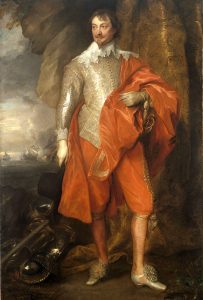
Robert Rich, 2nd Earl of Warwick, Lord of the Manor of Hunningham, portrait by Anthony van Dyck, Flemish Baroque artist who became the leading court painter in England after success in the Southern Netherlands and Italy
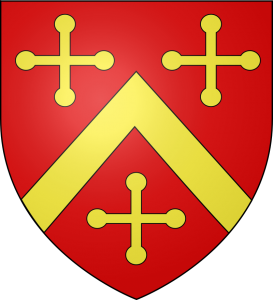
Arms of Robert Rich, 2nd Earl of Warwick, Lord of the Manor of Hunningham
During the first part of the seventeenth century, the lordship of the Manor of Hunningham had various lords, passing from Thomas Gibbes to John Woodward, then in 1614 to Timothy Wagstaff, and from him to Hannibal Horsey to which his son James Horsey succeeded who died in 1630, He left no son and the lordship of the Manor of Hunningham then passed to his daughter Dorothy.
In 1653 Colonel the Hon. George Fane married Dorothy Horsey and became Lord of the Manor of Hunningham, as evidenced by the interesting manuscripts of Stoneleigh Abbey at the Shakespeare Birthplace Trust registration office in Stratford on Avon. George Fane was the fifth but fourth surviving son of Francis Fane, 1st Earl of Westmorland and his wife, Mary Mildmay, daughter and heir of Sir Anthony Mildmay of Apethorpe, Northamptonshire. He was educated at Eton College from 1637 to 1632) and matriculated from Emmanuel College, Cambridge in 1632. He travelled abroad from 1635 to 1638, visiting Italy. In 1640, Fane was elected Member of Parliament for Callington in Cornwall, a seat controlled by the Rolle family of Heanton Satchville, Petrockstowe. By 1642, he was a Captain of an Irish foot regiment and was Royalist lieutenant colonel by 1643. He was colonel of a foot regiment from 1644 to 1649 and fought as a colonel at Marston Moor. Fane acquired the mortgage, in trust for his son, of a Thameside Berkshire estate at Basildon House in 1656 in the names of his sister, Rachael Fane (styled Lady Bath) and his nephew, Charles Fane, Lord le Despenser (later the third Earl of Westmorland and 10th Baron le Despencer). Following the Restoration he was a Justice of the Peace and a Deputy Lieutenant for Berkshire until his death. He was a Commissioner for assessment for Warwickshire from August 1660 to 1661 and one for Berkshire from 1661 to 1663. In 1661 Fane was elected MP for Wallingford in the Cavalier Parliament. He was one of the most active Members in the opening sessions of the parliament, serving on 84 committees.
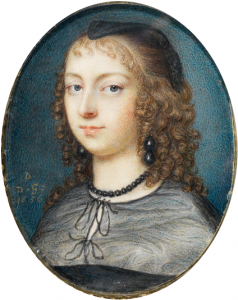
Miniature portrait of Lady Rachel Fane, sister of Colonel the Hon. George Fane, Lord of the Manor of Hunningham, 1656
Evidently Colonel the Hon. George Fane left the lordship of the Manor of Hunningham to his son Sir Henry Fane of Bassledon, Berkshire, who in 1687 mortgaged the manor and other lands to Anne Shute of Theobalds co. Hertford, for £ 1,600. When Anne Shute married Thomas Pickard, the mortgage was transferred to Francis Barrington and Thomas Abney. In 1690 Francis Barrington and Thomas Abney sold the mortgage to Viscountess Wimbledon to Sophia Lady.
Perhaps the Fane family had insoluble financial problems, since, in 1692, the Manor of Hunningham was sold to Thomas Watson of Tidmington co. Worcester and George Watson of Oxford. Thomas Watson and George Watson may have been property speculators, only a few years later, in 1695, they sold the Manor to Thomas Leigh, 2nd Baron Leigh.
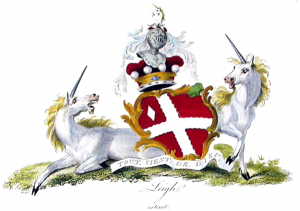
Coat of arms of the Barons Leigh
With this transfer of ownership in 1695, a very important period began in the history of the Manor of Hunningham. The Manor remained in fact owned by the prestigious Leigh family for almost 300 years, this long period has contributed to strengthening and preserving the Manor, especially as regards its historical identity.
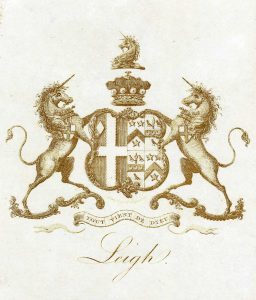
Ex libris of the Barons Leigh
Baron Leigh has been created twice as an hereditary title, once in the Peerage of England and once in the Peerage of the United Kingdom. The first creation came in the Peerage of England 1643 when Sir Thomas Leigh, 2nd Baronet, was created Baron Leigh, of Stoneleigh in the County of Warwick. The Leigh Baronetcy, of Stoneleigh in the County of Warwick, had been created in 1611 for his grandfather and namesake Thomas Leigh. The latter was the second son of Sir Thomas Leigh (d. 1571), Lord Mayor of London in 1558, whose third son Sir William Leigh was the grandfather of Francis Leigh, 1st Earl of Chichester. The titles became extinct on the death of the fifth Baron Leigh in 1786.
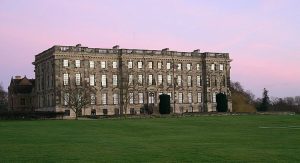
Stoneleigh Abbey, Warwickshire
The barony was revived in 1839 when the poet Chandos Leigh was created Baron Leigh, of Stoneleigh in the County of Warwick, in the Peerage of the United Kingdom. He was a descendant of Rowland Leigh, eldest son of the aforementioned Sir Thomas Leigh (d. 1571), himself of a cadet branch of the ancient Leighs of West Hall, High Legh. Both Lord Leigh’s son, the second Baron, and grandson, the third Baron, served as Lord Lieutenant of Warwickshire. The third Baron was succeeded by his nephew, the fourth Baron. The family seat is Stoneleigh Abbey, an country house and estate situated south of Coventry, nearby is the village of Stoneleigh, Warwickshire.
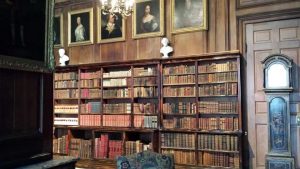
Stoneleigh Abbey, library
The first of the Leigh family Lord of the Manor of Hunningham was therefore Thomas, 2nd Baron Leigh, born in 1652, who bought the Manor from Robert Waring and John Cropper in 1695. At that time he was already married to his second wife Anne, daughter of the Earl of Strafford, his first wife had died a few years earlier. He and his first wife had no children, but his second wife had three children, the eldest of whom Thomas died before he could inherit his father’s estate.
His next son, Edward, aged 25, after his father’s death in 1710, became Lord of the Manor of Hunningham and the 3rd Baron Leigh. He followed in the footsteps of his father politically as and in 1705 he married Mary Paulet. Edward and his wife had two children, the eldest of whom died at the age of 18 in 1737, only a few months before his father.
When the 3rd Baron died, the title and properties, including the lordship of Hunningham, were inherited by the younger son Thomas, 4th Baron Leigh.
The 4th Baron was born in 1713 and in 1736 he married Maria Craven, with whom he had four children, however Lady Leigh died 1746. In 1747 Thomas Leigh married again, this time with Catherine Berkeley, but died shortly after, at the age of 36 years, without having other children.
His only surviving son, Edward, became Lord Leigh when he was only 7 years old, in 1749. He never married and in 1774 he was declared mad. He died in 1786 and as he had no children the title of Baron Leigh died out. By his will, which was written in 1768 before he was declared mad, the estates went to his sisters, jointly, and their children, among the sisters there was the Hon Mary Leigh, who became Lady of the Manor of Hunningham.
After the death of the Lady of Hunningham, the properties would be inherited “by the first and closest of my male relative and my name and blood”.
Although the barony died out on the death of the fifth baron, and was not claimed, in 1813 it was requested by George Leigh of Blackrod in Lancashire, along with the Manor of Hunningham, however this request was not accepted.
From 1806 after the death of Hon Mary Leigh, Leigh’s properties, including the lordship of Hunningham, passed to Rev Thomas Leigh, and from him, in 1813, to James Henry Leigh of Adlestrop, a distant cousin descended from the first Baron Leigh . When James Henry Leigh of Adlestrop died in 1823, the properties, passed to his son Chandos Leigh.
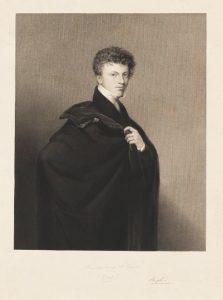
Chandos Leigh, 1st Baron Leigh, Lord of the Manor of Hunningham, stipple engraving, early 19th century
Chandos Leigh was a poet and was very influenced by Lord Byron with whom he had gone to school in Harrow. After school, he was registered at Christ Church Oxford. Like many students before this century, he left without a degree and completed his education by traveling extensively abroad. On his return to England, he joined many poets and playwrights of the time, such as Sheridan and of course Byron. He has published a large number of poetic works: The Island of love: A dream (London: W. Lindsell, 1812); Trifles Light as Air (London: G. Sidney, for F. Benedict, 1813); Juvenile Poems (London: W. Lindsell, 1815, London: G. Sidney, for F. Benedict, 1815); An Epistle to Emma: To a skull converted into a drinking bowl (London: G. Sidney, 1816; Verses. London: G. Sidney, 1816); Juvenile Poems, and other pieces (London: W. Lindsell, 1817); Dedicatory stanzas to Mary (in “Literary Gazette, and Journal of the Belles Lettres”, 31 January 1818, 73-74); Poems (London: W. Lindsell-Longman, Hurst, 1818); Poesy: A satire, with other poems (Warwick, UK: Henry Sharpe, 1818); The View (Warwick, UK: Henry Sharpe, 1819); England, and other poems (Warwick, UK: Henry Sharpe, 1820); The View, and other poems (London: 1820, 1822); Sylva: Poems on several occasions (London: T. & J. Allman-Edinburgh: W. Blackwood, 1823); Second Letter to a Friend in Town and other poems (London: E. Lloyd, 1824); A Third Letter to a Friend in Town &c. (Warwick, UK: Henry Sharpe, 1825); Epistles to a friend in town, Golconda’s fete, and other poems (London: Henry Colburn, 1826); Fourth Epistle to a Friend in Town, and other poems (Warwick, UK: Merridew, 1830); The Spirit of the Age (Warwick, UK: Merridew, 1832); Fifth Epistle to a Friend in Town, Warwickshire, and other poems (London: Richard Bentley, 1835); Poland (Warwick, UK: Merridew, 1836); Poems: Now first collected (London: Edward Moxon, 1839); A Vision [1840?]; Supplementary Verses (Warwick, UK: H.T. Cooke, 1841); Thoughts at Whitsuntide, and other poems (London: Edward Moxon, 1842); Walks in the Country (London: Edward Moxon, 1844); Minor Poems (Leamington, UK: Taylor, Glover, 1850). He also published the following writings: Fragments of Essays (London: G. Sidney, 1816); A Short Discourse on Natural and Revealed Religion (Warwick, UK: H. Sharpe, 1821); Tracts: Written in the years 1823 & 1828 (Warwick, UK: printed by J. Merridew, 1832).

Books by Chandos Leigh, 1st Baron Leigh, Lord of the Manor of Hunningham
These works were highly appreciated by the public and also by Byron. Together with Byron, he was friends with many young liberals such as Lord Althorp and Sir James Mackintosh, who at the time met regularly in Holland House. In 1839 was created Lord Leigh of Stoneleigh by the liberal government of the time: he was the first baron of the new creation. He was very interested in politics and social problems of the time and took part in debates in the House of Lords, where he could have put some of his ideas into practice. However, although he had shown interest in liberal politics, he was rarely in the House of Lords, but preferred to stay in Warwickshire, where he was a magistrate. In 1819 he married Margarette Willes daughter of a priest. The spouses had the typical large Victorian family, with ten sons, three sons and 7 daughters, including two groups of twins, all of whom survived.
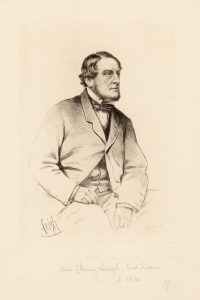
William Henry Leigh, 2nd Baron Leigh, Lord of the Manor of Hunningham, etching, 1880s-1890s
When Chandos Leigh died of apoplexy and paralysis in 1850, his son William Henry became the 2nd Baron and Lord of the Manor of Hunningham. This Lord Leigh, along with his younger brother Edward, inherited his father’s interest in politics. Edward was an adviser to the President of the House of Commons from 1883-1907 and William ran as a liberal candidate for North Warwickshire in 1847.
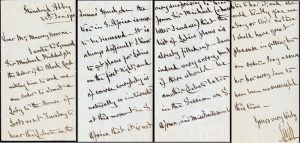
William Leigh, 2nd Baron Leigh, Lord of the Manor of Hunningham, autographed signed letter, Stoneleigh Abbey, 28th January 1900
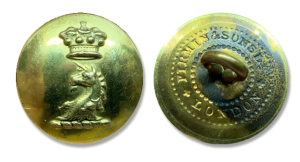
Button of the Barons Leigh, 19th century
William Leigh, 2nd Baron Leigh and Lord of Hunningham, was Lord Lieutenant of Warwickshire from 1856 until his death and was also made a colonel in the 3rd Battalion of the local regiment, the Warwickshire Regiment. He was High Steward of Sutton Coldfield from 1859 until 1892, when the stewardship lapsed after a new charter was issued for the borough, but was reappointed in September 1902. He also held office as a Justice of the Peace for Gloucestershire. He donated the land for the construction of St Alban’s Church, Holborn in central London.
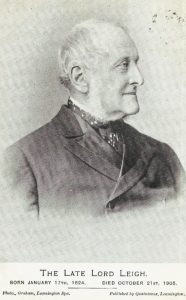
William Henry Leigh, 2nd Baron Leigh, Lord of the Manor of Hunningham, postcard, 1905
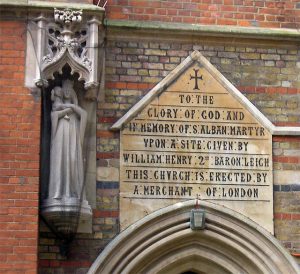
Inscription to William Henry Leigh, 2nd Baron Leigh, Lord of the Manor of Hunningham, at St Alban’s Church
In 1848 he married Caroline, one of the daughters of the Marquis of Westminster, and had 7 children. Their eldest son Gilbert Henry Chandos Leigh tragically died on an expedition to Wyoming, his body was found at the bottom of a canyon after several days, so that when his father died in 1905 the properties were inherited by a younger son, Francis Dudley Leigh, 3rd Baron Leigh, who became Lord of the Manor of Hunningham.
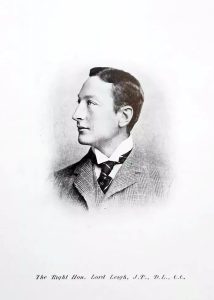
Francis Dudley Leigh, 3rd Baron Leigh, Lord of the Manor of Hunningham, print derived from E. Gaskell, Cheshire leaders. Social and political, London, 1896
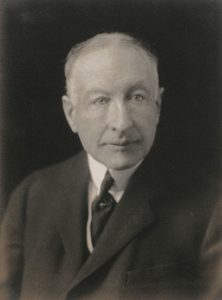
Francis Dudley Leigh, 3rd Baron Leigh, Lord of the Manor of Hunningham, bromide print, 1921
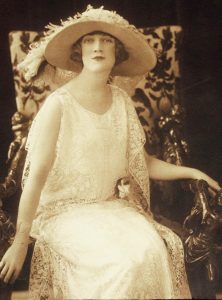
Marie Campbell, Lady Leigh, Lady of the Manor of Hunningham, second wife of Francis Dudley Leigh
The 3rd Baron Leigh married twice with American women, but had no children. His second wife was Marie Campbell, who became Lady Leigh and Lady of the Manor of Hunningham. Despite the age difference, they achieved perfect happiness, in married life they were very close and loved each other deeply.
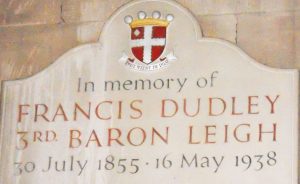
Francis Dudley Leigh, 3rd Baron Leigh, Lord of the Manor of Hunningham, commemorative plate
Francis Dudley Leigh died in May 1938. After his death, the Lordship of Hunningham then passed on to his grandson Rupert William Dudley, the eldest son of his brother Rupert, who became the 4th Lord Leigh. Rupert William Dudley, who married Anne Hicks-Beach, was a member of the National Hunt Committee and one of the members for Warwickshire on the Council of the Royal Agricultural Society of England, acting as Steward of the Grand Ring at the Royal Show.
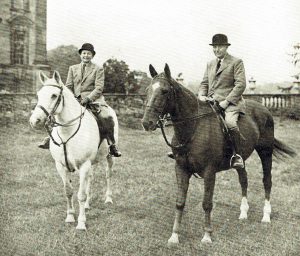
Rupert William Dudley Leigh, 4th Lord Leigh, Lord of the Manor of Hunningham, with his wife Anne Hicks-Beach, Lady Leigh, Lady of the Manor of Hunningham, during a horseback ride, photo, December 1953
After the death of Rupert William Dudley Leigh in 1979, the Lordship of the Manor of Hunningham, along with the other Leigh estates, was inherited by John Piers Leigh, the 5th Baron Leigh.
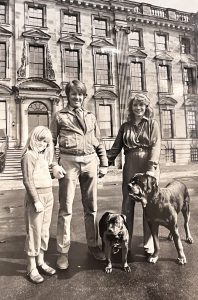
John Piers Leigh, 5th Baron Leigh, Lord of the Manor of Hunningham, with his family and his faithful dogs, Stoneleigh Abbey in the background, photo, 1984
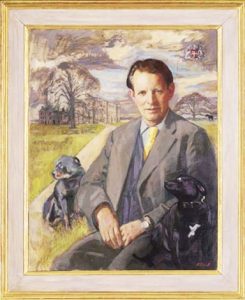
John Piers Leigh, 5th Baron Leigh, Lord of the Manor of Hunningham, with his faithful dogs, Stoneleigh Abbey in the background, oil on canvas by R. Tilliot, around 1990
In 1989, the lordship of the Manor of Hunningham, after 300 years, ceased to be owned by the Barons Leigh, because it was sold by John Piers Leigh, the 5th Baron Leigh, to Roy Chew of Hill House in Hunningham. Roy Chew has initiated important historical scientific research on the Manor oh Hunningham, hiring historians and academics of international renown, who have worked hard to write the history of the lordship that has lasted for a millennium.
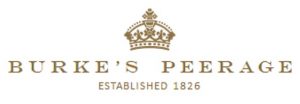
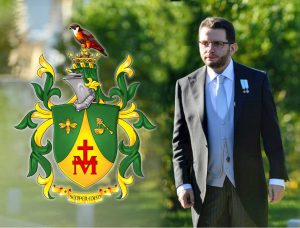
Prof. Luca Lombardi, Lord of the Manor of Hunningham
In 2020 the Lordship of the Manor of Hunningham was transferred to Prof. Luca Lombardi of Bari, Italy, who is the current Lord of Hunningham and owner of all the rights associated with it. Prof. Luca Lombardi is a historical and numismatic researcher, publisher, is a life member of The Manorial Society of Great Britain, founded in 1906, is a member of Historical Families of Europe, founded in 2011, of the Italian Genealogical Heraldic Institute, founded in 1993, of the Società Napoletana di Storia Patria, founded in 1875, of the Società Numismatica Italiana, founded in 1892; he is the author of books and scientific studies and organizer of international exhibitions and conferences. Prof. Luca Lombardi has a vast historical archive of the Manor of Hunningham, consisting of manuscripts, certificates, maps, photographs, various types of documents starting from the 17th century. The archive is made available to researchers for historical scientific insights.
